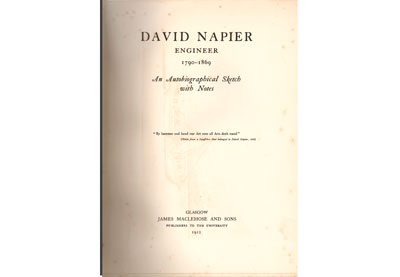Description
David Napier was a ship owner, and shipbuilder, but foremost an engineer, who developed a thriving business on the Clyde. He was associated with the pioneers Henry Bell and William Symington and his autobiography is very informative on the subject of early steamboat development. In 1837, having built engines for around forty steamboats, at the age of 46 Napier moved south to London, where he purchased a site at Millwall, next to that belonging to William Fairbairn, Here he established a shipyard, trading as J. & F. Napier, passing the management to his two sons. He built an agreeable four square early Victorian villa, “Napier House” on the site, where he lived and occupied himself with experimental and design work. He has the dubious distinction of being the only London engine builder to have two vessels blow up on the Thames in successive years.
On a more positive note, he patented the “Steeple” engine for paddle steamers, and invented a highly efficient water condenser. The hot water was pumped through the double bottom of the vessel, cooled by seawater outside the hull and a flow of seawater above the hot, beneath an additional deck. The problem was that corrosion was inevitable and invisible. Nothing could be done without tearing the vessel apart. Napier also had some degree of success in propeller experiments involving two contra rotating fan blades.
The book has some useful tables giving details of early steamers and a lengthy section dealing with Napier’s time in London. ESSENTIAL READING FOR ANYONE INTERESTED IN THE HISTORY OF SHIPBUILDING ON THE THAMES.
PREVIEW BELOW – MAY TAKE A WHILE TO LOAD.

Reviews
There are no reviews yet.